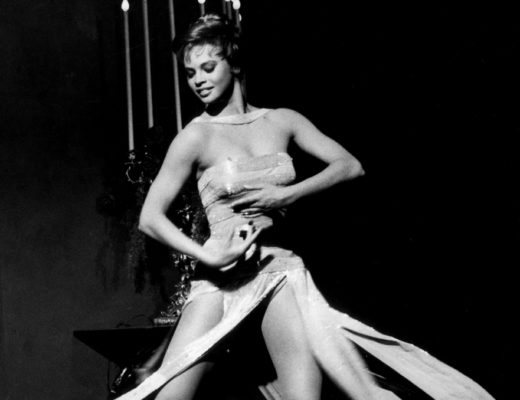Happy Hump Day Voxfrockers! Have we got a pocket full of princesses for you. Settle back as Voxfrock guest columnist, roving royal reporter and connoisseur of All Things Fabulous, Shiva “The Count” Singam, reflects on the life of Egypt’s last Princess, Fawzia, and the Middle Eastern beauties who set the glamourmeter to HIGH in her wake…
She was only 17. The beautiful Egyptian Princess Fawzia captured the hearts of her people as she stood in her Chanel wedding dress, laden with diamonds in jewellery designed by Van Cleef and Arpel, on the terrace of Cairo‘s Abdeen Palace with her handsome 20-year-old Iranian prince at her side. And so, on March 16, 1939, with the world on the brink of war, the Middle East rejoiced at a wedding of empires. It was a union heavy with political significance, with Britain playing the part of matchmaker to strengthen the links between Iran and Egypt.

Educated in Switzerland, Princess Fawzia first met Mohammad Reza Pahlavi, who two years later became Shah of Iran, on their wedding day and only after the marriage contract had been drawn. “The blessed royal marriage,” as it was described by local newspapers, received saturation coverage in the media, down to the gifts brought over by the groom and photographed for the public to see including three precious pearl necklaces, a diamond ring, a mirror, and a beautifully hand-printed Quran. Then as now, the world loved a fairy tale princess and Princess Fawzia did not disappoint; the public was enamoured by her royal graces, fashions and poise.

Princess Fawzia counted amongst her friends the likes of Parisians Elsa Schiaparelli, Coco Chanel, a young Christian Dior, Jacques Faths and Jacques Cartier, all of whom fed her taste for luxurious garments and jewels. She looked like a movie star and became one of the most recognised faces in the world, captured on the cover of Life magazine in September 1942 as the “Queen of Iran” by legendary photographer Cecil Beaton. The “queen”, Beaton wrote: “Had sad and mournful eyes, pitch-black hair, a perfectly sculpted face and soft, graceful hands bereft of the wrinkles of labour.”
The royal marriage however, lasted barely 10 years, producing a single daughter, Princess Shahnaz Pahlavi. The divorce, in November 1948, was officially attributed to the health risk posed to the queen by the “Persian climate”. By 1952 and the Egyptian revolution that toppled the royal family, Princess Fawzia, daughter of one king, sister to a second, and wife to a third monarch, fell on hard times. She was almost forgotten until her death in 2013 at the age of 92 in Alexandria.
Her simple funeral was captured on phone cameras and attended by just a handful of family members and friends. The last Egyptian princess and first wife of the Shah of Iran, was buried next to her second husband, Ismail Chirin an Egyptian army officer in Cairo with whom she had had two children; a daughter and a son.
“She led a very secluded and simple life compared to her sisters, who continued to make headlines throughout their lives,” confided a family friend. “She didn’t go out much in public, and surrounded herself with just the closest family and friends. She was the last Egyptian princess living in Egypt. From queen, to living on a very basic income, it was a hard fall, but she took it all in great stride and style.”
Fawzia was a discreet contrast to her sisters. Fathia, the youngest, was killed in 1976 by her ex-husband, who shot her six times with a revolver. Faika, the second-youngest, married an Egyptian commoner in the United States, in a civil marriage that her brother, exiled King Farouk, initially refused to endorse. Princess Faiza was active with the Red Crescent in Egypt during her brother’s reign.

By the time of Fawzia‘s death in 2013, all in her family had already passed away. The nostalgia brought on by her passing was captured through the condolences and prayers posted on her official Facebook page. “Rest in peace, beautiful princess,” most wrote. “We want beautiful princesses and handsome princes again in Egypt,” wrote one hopeful.
One insight into the private life of the gentle and quiet princess who rarely made public speeches, was written in the 1992 book, The Rise and Fall of the Pahlavi Dynasty: Memoirs of Former General Hussein. The author describes how Princess Fawzia communicated with her husband in French. She did not speak Farsi and the Shah did not speak Arabic. “She was extremely pretty but languidly shy,” General Hussein wrote. “She was, in no way willing to attend official banquets. Whenever she talked to people, her beautiful face turned red.”
Even today, the princesses and queens of the Arab world still capture the imagination of the masses and set trends in both the political and social arenas.
Queen Rania of Jordan, like her predecessor, Queen Noor of Jordan, Princess Lalla Salma of Morocco, Sheikha Mozah of Qatar, Princess Haya Bint Al Hussein, wife of the Vice President and Ruler of Dubai, Sheikh Mohammed bin Rashid and Princess Ameerah Al Taweel, wife of the Saudi Prince Al Waleed bin Talal, are just some of the royals today who have become fashion icons and among the most photographed women in the Middle East.
Shiva “The Count” Singham, info@voxfrock.com.au


